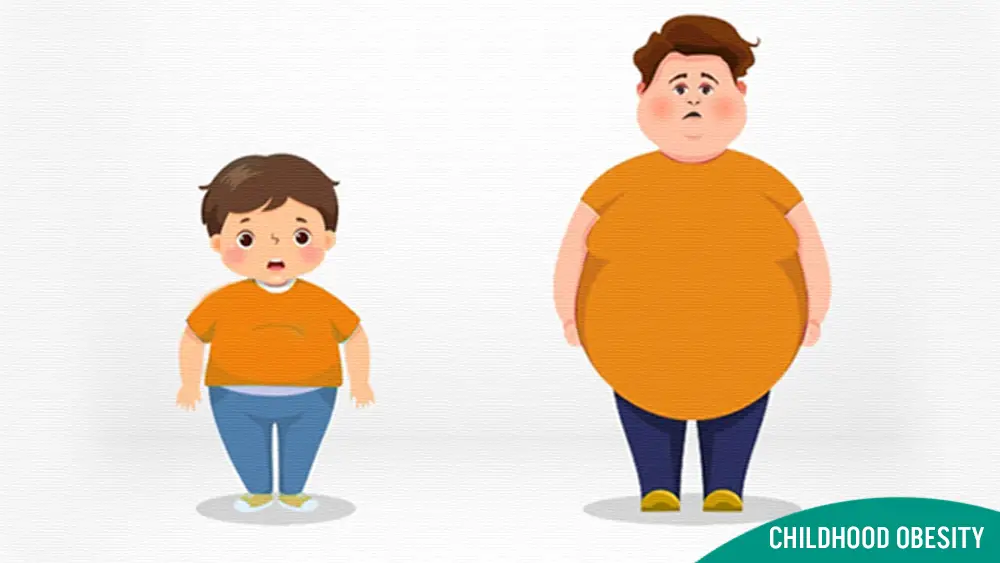
HEALTH NEWS
Complete Each Sentence about Childhood Obesity and Overweight Statistics
-
Rahul Priydarss
Discover the complexities of childhood obesity and effective policy interventions in this comprehensive article. Learn about the causes, health risks, prevention strategies, and collaborative efforts aimed at combating obesity by 2030. Explore the role of genetics, diet, physical activity, and socioeconomic factors in shaping this global health challenge.
What is Childhood Obesity:
Childhood obesity is a significant health concern affecting children and adolescents worldwide. It is characterized by excess body fat that poses a risk to a child’s overall health and well-being. In this article, we will delve into the causes, health risks, prevention, and management strategies related to childhood obesity.

Table of Contents
Causes of Childhood Obesity:
Genetics: Genetic factors play a role in predisposing some children to obesity. Children with obese parents are more likely to become obese themselves due to inherited genetic traits that influence metabolism and fat storage.
Diet and Nutrition: Poor dietary habits, such as consuming high-calorie, low-nutrient foods and sugary beverages, contribute to childhood obesity. A diet rich in processed foods, fast food, and snacks high in sugar and fat can lead to weight gain over time.
Lack of Physical Activity: Modern lifestyles often involve sedentary activities like watching television, playing video games, and using computers or smartphones. Insufficient physical activity coupled with excessive screen time contributes to weight gain and obesity in children.
Socioeconomic Factors:
Children from low-income families may face challenges accessing affordable, nutritious foods and safe recreational spaces for physical activity. Economic disparities can influence dietary choices and lifestyle behaviors, contributing to higher rates of obesity in certain communities.
Effecting Factors to Childhood Obesity:
- Genetics: Genetic predisposition can influence a child’s susceptibility to obesity.
- Dietary Habits: Poor dietary choices, including excessive consumption of high-calorie, low-nutrient foods, contribute to weight gain.
- Physical Activity Levels: Sedentary lifestyles with limited physical activity exacerbate the risk of obesity.
- Socioeconomic Status: Economic factors can impact access to healthy food options and opportunities for physical activity.
- Environmental Influences: Factors such as food marketing, neighborhood safety, and availability of parks and recreational facilities influence lifestyle choices.
Child Obesity Policy Goals:
Prevention: Implement measures to prevent childhood obesity through education, promotion of healthy behaviors, and environmental changes.
Intervention: Provide support and resources for children and families affected by obesity to facilitate healthy lifestyle changes and prevent associated health complications.
Key Components:
Education and Awareness: Develop educational campaigns to raise awareness about the risks of childhood obesity and the importance of healthy eating and physical activity.
Nutrition Standards: Establish and enforce nutrition standards for foods and beverages served in schools, childcare facilities, and other settings frequented by children.
Physical Activity Promotion: Promote opportunities for physical activity in schools, communities, and recreational facilities to encourage regular exercise.
Screen Time Regulation: Implement guidelines to limit screen time and encourage children to engage in more active pursuits.
Access to Healthy Foods: Ensure access to affordable and nutritious foods in underserved communities through initiatives such as farmers’ markets, community gardens, and subsidies for healthy foods.
Support for Families: Provide resources, counseling, and support services for families to help them make healthier choices and adopt sustainable lifestyle changes.
Healthcare Interventions: Integrate obesity prevention and management into healthcare systems, including regular screenings, counseling, and referrals to specialized services when needed.
Policy Evaluation: Regularly evaluate the effectiveness of obesity prevention policies and programs to identify areas for improvement and ensure accountability.

Stakeholder and Government Engagement:
Involve stakeholders from various sectors, including government agencies, healthcare providers, educators, community organizations, and the food industry, in the development and implementation of childhood obesity policies. Foster collaboration and coordination among stakeholders to maximize the impact of interventions and address the complex underlying factors contributing to obesity.
Legislation and Regulation: Enact legislation and regulations at the local, state, and national levels to support obesity prevention efforts, such as mandating nutrition education in schools, restricting advertising of unhealthy foods to children, and incentivizing businesses to offer healthier options.
Public Support and Advocacy: Mobilize public support for childhood obesity policies through advocacy campaigns, grassroots initiatives, and partnerships with influential stakeholders. Raise awareness about the social and economic costs of obesity and the importance of investing in prevention and treatment efforts.
Child Obesity in Adolescents:
Prevalence and Trends: Highlight the increasing rates of obesity among adolescents globally, reflecting shifts in diet, physical activity patterns, and societal norms.
Factors Contributing to Adolescent Obesity:
Unhealthy Dietary Habits: Consumption of high-calorie, low-nutrient foods and sugary beverages.
Sedentary Lifestyle: Decreased physical activity due to increased screen time and reduced participation in sports or outdoor activities.
Genetic and Environmental Factors: Genetic predisposition coupled with environmental influences such as family dynamics, socioeconomic status, and community resources.
Psychosocial Factors: Stress, depression, and body image issues that may lead to disordered eating behaviors.

Health Consequences:
Adolescents with obesity are at higher risk of developing chronic conditions such as type 2 diabetes, cardiovascular diseases, hypertension, and musculoskeletal disorders.
Obesity in adolescence can also have significant psychosocial consequences, including low self-esteem, social isolation, and increased risk of mental health disorders like depression and anxiety.
Prevention and Intervention Strategies:
Promoting Healthy Eating Habits: Encourage the consumption of nutritious foods such as fruits, vegetables, whole grains, and lean proteins while limiting intake of processed foods and sugary snacks.
Encouraging Physical Activity: Provide opportunities for regular exercise and participation in sports or recreational activities both within and outside of school.
Addressing Environmental Factors: Create supportive environments that facilitate healthy choices, including access to affordable, nutritious foods and safe spaces for physical activity.
Education and Awareness: Offer comprehensive health education programs in schools covering topics such as nutrition, physical activity, body image, and mental health.
Family and Community Involvement: Engage families, caregivers, and community organizations in promoting healthy behaviors and providing support for adolescents struggling with obesity.
Clinical Interventions: Provide access to multidisciplinary healthcare teams including physicians, dietitians, psychologists, and exercise specialists to support adolescents in managing their weight and addressing related health issues.
Policy Implications:
Advocate for policies at the local, state, and national levels that support obesity prevention efforts in schools, healthcare settings, communities, and the built environment. Examples include implementing nutrition standards in school meal programs, restricting marketing of unhealthy foods to adolescents, and investing in infrastructure to promote physical activity.
Child Obesity by 2030:
Projected Trends: Analyzing current data and trends suggests that without significant intervention, rates of childhood obesity are likely to continue rising, leading to a higher prevalence of obesity-related health issues among children and adolescents.
Factors Influencing Projections:
Globalization of Unhealthy Diets: Increased availability and consumption of processed foods high in sugar, fat, and salt contribute to poor dietary habits among children worldwide.
Sedentary Lifestyles: Prolonged screen time, reduced physical activity, and limited access to safe outdoor spaces for recreation contribute to a sedentary lifestyle, exacerbating the risk of obesity.
Social Determinants of Health: Socioeconomic factors, cultural norms, and disparities in access to healthcare and healthy food options disproportionately affect vulnerable populations, contributing to higher rates of obesity.
Technological Advances: Advances in technology may further promote sedentary behaviors and unhealthy eating habits among children if not balanced with efforts to promote physical activity and healthy lifestyles.
Potential Health Implications by 2030:
By 2030, the prevalence of childhood obesity may result in a surge of obesity-related health conditions, including type 2 diabetes, cardiovascular disease, hypertension, and mental health disorders among children and adolescents. The economic burden of treating obesity-related health conditions could escalate, placing strain on healthcare systems and society as a whole.
Strategies to Reduce Childhood Obesity by 2030:
Early Intervention Programs: Implement evidence-based interventions targeting children and families from an early age to instill healthy habits and prevent the onset of obesity.
School-Based Interventions: Strengthen nutrition and physical education programs in schools, establish healthy food environments, and promote active transportation to and from school.
Community Engagement: Engage communities in creating supportive environments for healthy living through initiatives such as community gardens, farmer’s markets, and safe recreational spaces.
Policy Advocacy: Advocate for policies at local, national, and international levels that support obesity prevention efforts, including food and beverage regulations, urban planning initiatives, and healthcare reforms.
Media and Marketing Regulations: Implement regulations to restrict the marketing of unhealthy foods and beverages to children and promote positive portrayals of healthy lifestyles in media targeted at young audiences.
Collaboration and Monitoring:
Foster collaboration among governments, healthcare organizations, educators, community leaders, and the private sector to implement and monitor the effectiveness of obesity prevention strategies. Regularly monitor and evaluate progress towards reducing childhood obesity rates, adjusting interventions as needed to achieve meaningful outcomes by 2030.
FAQs about Childhood Obesity:
A1: Childhood obesity is excessive body fat accumulation in children and adolescents, posing health risks.
A2: Factors include genetics, poor diet, lack of physical activity, socioeconomic status, and environmental influences.
A3: It increases the risk of chronic diseases and psychosocial issues, impacting overall well-being.
A4: Strategies include promoting healthy eating, increasing physical activity, regulating screen time, and providing support for families.
A5: Policies focus on education, nutrition standards, physical activity promotion, and healthcare integration to address this pressing issue.
-Please remember, to always consult with healthcare professionals or Doctors for personalised advice related to medical conditions.
Conclusion:
Childhood obesity presents a global health challenge, driven by factors like genetics, diet, and sedentary lifestyles. Effective policy interventions focusing on prevention and intervention are crucial. By promoting healthy habits, regulating environments, and fostering collaboration, we can mitigate obesity’s impact by 2030, ensuring a healthier future for children.
Previous Post




